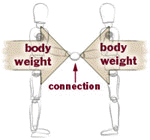Leading and Following in Open Positions
The Concept of Push and Pull
Push & Pull: Tension applied to a connection through the direction of body weight toward it (Push) or away from it (Pull).
Do not be fooled by the slightly misleading terms... Push and pull have very little
to do with an actual pushing or pulling action of the hands and arms. As the
definition suggests, the concept of Push & Pull center around the direction
of body weight, either toward or away from a connection.
Push |
Pull |
 |
 |
When both partners shift the body weight towards each other at the same time, the result is a tension which creates a "pushing" sensation through the connection. |
When both partners shift the body weight away from each other at the same time, the result is a tension which creates a "pulling" sensation through the connection. |
Push
To achieve the feeling of "push", you and your partner should shift your weight
towards each other to the point that you can feel each other's body weight
working into the connection. This will create a natural tension through the
connected hands.
PITFALLS...
-
Be careful with your interpretation of "shifting weight forward". It should not be necessary to literally pitch your body forward. A good weight connection can be established almost invisibly, without any change in your posture.
-
Don't allow the elbows to compress backwards behind the hips as push is applied to them. Make sure that you have enough tone in the muscles to maintain the position of the arms and hands.
-
The hands and arms should use enough muscle tone to maintain their position, but not so much that they actually push on their own. Whenever hands and arms try to act on their own, they stop transmitting signals which are being sent by the body, and the true communication gets interrupted. It's very easy to fool yourself into thinking you have a weight connection, when in fact you and your partner are really just superficially tugging at each others' limbs.
Pull
To achieve the feeling of "pull", you and your partner should shift your weight away from each other to the point that you can feel each other's body weight working away from the connection. This will create a natural tension through the connected hands.
PITFALLS...
- Once again, don't confuse "shifting weight backwards" with literally pitching or slouching backwards. A pull connection only requires a subtle shifting of weight backwards, without any change of posture.
-
Don't allow the elbows to extend or straighten as pull is applied to them. Make sure that you have enough tone in the muscles to maintain the bent position of the elbows.
-
At the same time, remember not to use too much tension. The most common symptom of overuse of arm muscles when pulling is the contracting of the elbows towards the body.
Don't forget that connection is mutual! Push or pull therefore require both partners to be shifting their body weight toward or away from each other at the same time. It just doesn't work when one partner shifts weight toward while the other shifts away. Part of the skill of following therefore involves the reaction on the part of the follower to the leader's suggestions of push and pull. Exercises later in this lesson will focus on developing this skill.


